
PRE-1700
The Marechkawick and Dutch Colonization
The first residents of DUMBO were most likely a Native American tribe known as the Marechkawick. The Manatus Map of 1639 locates their main village in the vicinity of current-day Brooklyn Heights. The Marechkawick grew corn, foraged in the forests of Brooklyn, and fished in the East River, but their lives would soon be destroyed with the onset of colonization. Dutch colonists first settled in Manhattan in the early 1600s, but soon expanded into Long Island with the first recorded purchase of Native American land in Brooklyn in 1636. Although, the consent of the Native Americans involved in the deal is dubious.
A CONSIDERABLE NUMBER OF INDIANS LIVE UPON [LONG ISLAND], WHO GAIN THEIR SUBSTANCE BY HUNTING AND FISHING.
DUTCH MISSIONARY TRAVELERS, DAWCKER AND SLUYTER, 1679
Throughout the seventeenth century, Dutch settlers took over soon-to-be Brooklyn by means of legal land purchases, land theft, and violence. The formerly Marechkawick territory passed through the hands of early Dutch colonizers who established small farms and trading operations on the land that would become DUMBO. By 1700, the majority of Brooklyn’s waterfront was owned by the Rapelje family, one of the first Dutch settlers in the area.
1700'S
Revolution and Repercussions
The British beat the Dutch out of the Northeast in the later 1600s and by the eighteenth century reorganized the Dutch towns of Brooklyn into a single county. Life in the newly christened King’s County was primarily agriculture-centered and the county had one of the highest percentages of slaves in the thirteen colonies. Then, in 1776, those colonies declared their independence from British rule. That summer, the Patriot army fought the first and largest battle in their war for independence right here in Brooklyn – across the neighborhoods we now know as Brooklyn Heights, Park Slope, Fort Greene, Downtown Brooklyn and DUMBO.
British forces landed in New York Harbor with 32,000 troops, outnumbering the Patriots three to one. With the enemy advancing towards the main Patriot camp in Brooklyn Heights, it seemed that the war would be over as soon as it began. But General George Washington managed to escape crushing defeat by retreating across the East River at the Fulton Ferry Landing in the dead of night and early morning, losing New York to his opponents, but saving his men and supplies. The Patriots lost the Battle of Brooklyn, but they survived to win the war for independence.
PLYMOUTH STREET TAKES ITS NAME FROM PLYMOUTH, MASSACHUSETTS, WHERE THE SANDS’ ANCESTORS LANDED IN 1658.
The British occupied Brooklyn until the surrender at Yorktown in 1789. Like many Brooklyn landowners, the Rapelje’s allied themselves with the British during the war, and faced the consequences. The newly formed United States government confiscated their land in 1779. New owners Comfort and Joshua Sands paid $12,000 to the Commissioners of Forfeiture for 160 acres of waterfront land and called named the settlement Olympia. Originally, Olympia was envisioned to be a summer retreat due to it’s river breezes and close proximity to the water. However, families from New England migrated to the new community, supplementing the agricultural industry with small manufacturing and trade operations. These new inhabitants occupied multi-story, mixed-use brick and wood buildings, with a store on the bottom and living quarters on top. Erasing the idea of a summer retreat completely and focusing more on the industrial aspect.
1800'S
Growing Up and Out
The culture of DUMBO changed drastically with the addition of two major modes of transportation over the course of the nineteenth century. Robert Fulton established the Fulton Ferry in 1813 on the edge of the DUMBO waterfront, connecting Brooklyn and Manhattan. Families flocked to Brooklyn, with breadwinners commuting to work in Manhattan via the ferry. Between 1810 and 1850, the population rose dramatically, making Brooklyn the third most populous city in the United States.

The city also grew in physical size: over the first half of the nineteenth century, Brooklyn residents systematically extended the shore 500 feet into the East River by filling in land, moving the shoreline from Water Street to where it stands today. By the early 19th century, Dumbo had also become a notable free black community. Dumbo was home to the first school for black children in Brooklyn and abolitionist organizations such as the Brooklyn African Woolman Benevolent Society.
By the 1860’s, Brooklyn’s own industry was booming; huge brick warehouses dominated the waterfront, earning Brooklyn the nickname, “The Walled City.” DUMBO warehouses stored and processed goods from all around the world, from animal hides to indigo to tobacco, while thousands of workers in the busy factories manufactured ground coffee, soap and ceramics. The Brooklyn Bridge opened in 1883 and further connected the city to Manhattan. Adding to the DUMBO rail network was the Brooklyn Elevated Railroad, which established the Brooklyn Main Line along York Street, stopping at Washington Street and Bridge Street.
Packaging and marketing tycoon Robert Gair capitalized on Brooklyn’s growth and moved his business from Tribeca to DUMBO in 1888. Gair had invented the folded cardboard box in 1879. Thanks to this and other innovations, his company had outgrown Manhattan. Gair purchased numerous lots in DUMBO and transported his equipment across the newly built Brooklyn Bridge, making the start of a new era in manufacturing. As the turn of the century approached, Brooklyn stood as a pioneer of industry.
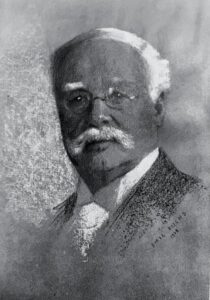
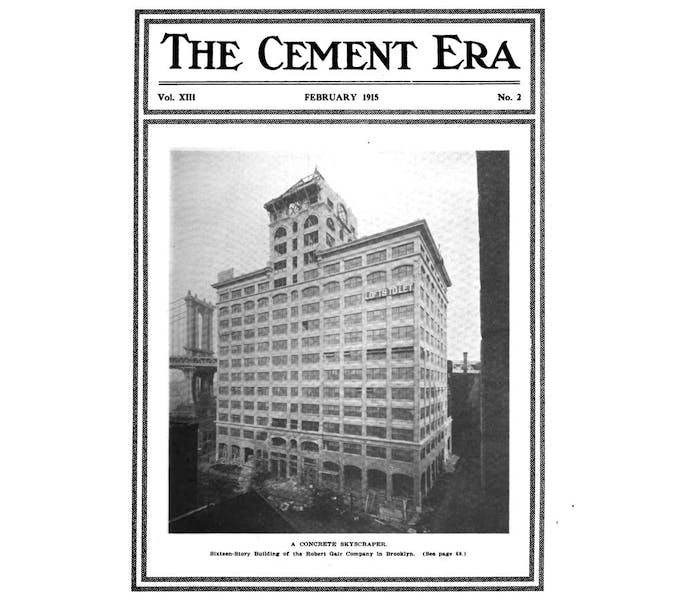
in 1905, Gair partnered with then three-year old Turner construction company to build his 180,000 square foot building at 55 Washington St. Concrete was fire proof, useful for a man in the business of making cardboard, and the building was far more stable, useful for the printing arm of his business. At the time, 55 Washington St was the largest reinforced concrete building in the United States. Legend has it that Gair and Turner lit a bonfire on the roof once the building was completed, to prove it was, indeed, fire proof.
1900'S
Industry Rises, Falls, and Rises Again
At the turn of the century, DUMBO continued its industrial growth. Brooklyn officially became a borough of New York City in 1898, and by 1900 was home to 10,713 factories employing 100,881 people. In DUMBO, these factories included Hanan & Co shoe manufacturers, the makers of the Brillo pad, Kirkman & Sons soap, Jones Brothers Tea and a new innovation … processed coffee! Arbuckle Coffee was founded by Charles Arbuckle, Robert Gair’s friend. Arbuckle utilized Gair’s services to package and market his roasted coffee beans, the first of their kind to be sold in the U.S.
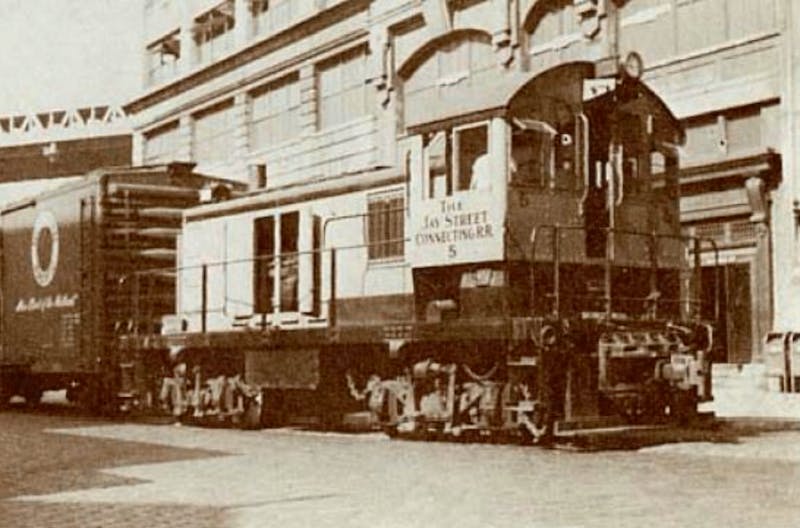
As the DUMBO manufacturing industry developed, so did its infrastructure. Gair contracted Turner Construction Company to build the first ever reinforced concrete building at 55 Washington Street. Soon, Gair’s newfangled buildings took up 37 acres of Brooklyn land, giving DUMBO the new name of Gairville. At the same time, Charles Arbuckle established the Jay Street Connecting Railroad to transport goods from barges to his Ariosa coffee factories. Finally, the Manhattan Bridge opened in 1909, pioneering modern suspension technology, and further connecting Brooklyn to the rest of the city. Borough planners wished to use rapid transit to create a shopping district in Downtown Brooklyn that would rival that of midtown Manhattan and, in 1935, the Independent Subway System opened stops at York and Jay Streets, analogous to today’s F-line.
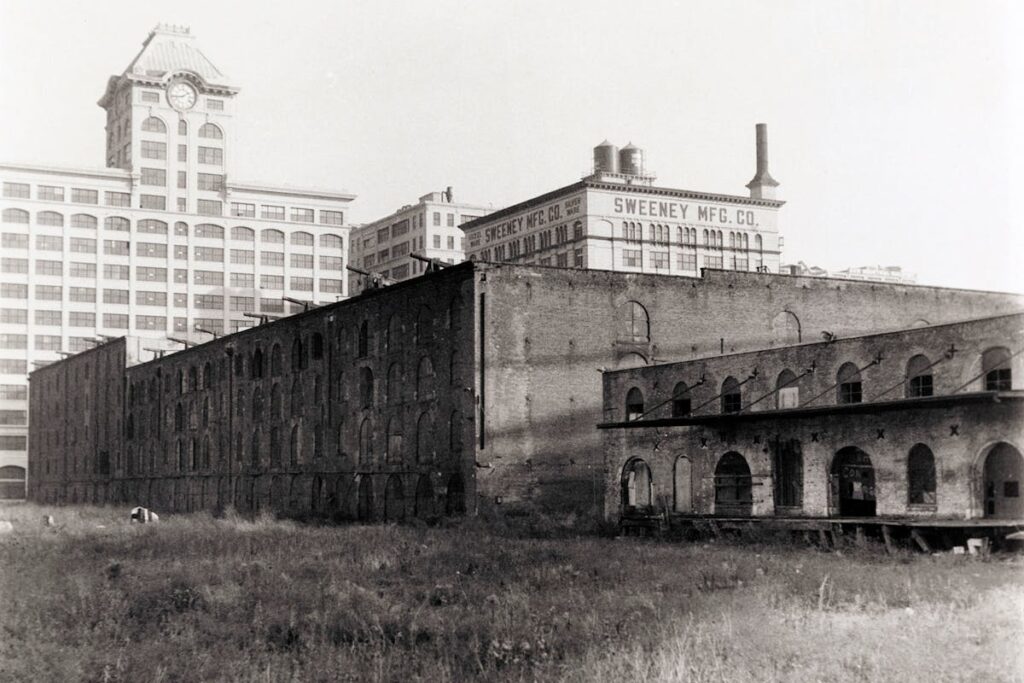
But national economic and cultural shifts caused changes to the DUMBO manufacturing scene. In 1927, Robert Gair’s son, George, moved Gair production out of Brooklyn to Piermont, New York in search of larger factory areas and cheaper costs. This move foreshadowed the departure of most major manufacturers from DUMBO by the mid-twentieth century. First, the Great Depression hit, causing mass layoffs and closures. Then came the post-World War Two exodus to the suburbs, leaving New York City with a shrinking population and financial strain. Eventually, the industrial titans of DUMBO all deserted the city, including Kirkman Soap, Hanan & Son Shoes, Brillo Pad and Arbuckle Coffee. The warehouses once known as Gairville remained only partially occupied by small-scale tenants, such as small paper goods manufacturers.
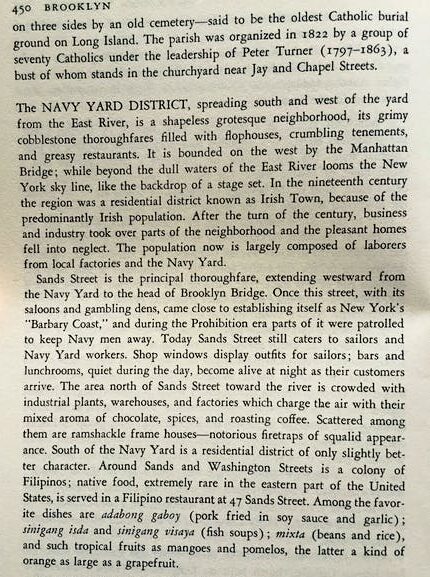
In the 1970’s, new blood came to DUMBO: artists began to move into the vacant floors of industrial buildings, sometimes illegally, to live and work. Fleeing gentrification in Manhattan, marginalized artists and activists such as DUMBA, a collective living space and anarchist, queer community center, made their home in DUMBO. Then, in 1981, real estate developer David Walentas and his company Two Trees Management Company purchased two million square feet of DUMBO real estate for $12 million. After Walentas waged a long campaign resulting in a 1997 rezoning, DUMBO as we know it began to form. Walentas offered free or reduced rent to businesses who were willing to take a chance on the fledgling neighborhood, attracting the now-classic Gleason’s Gym and Jacques Torres Chocolatier.
TODAY, 55 WASHINGTON HOSTS THE OFFICES OF VICE MEDIA, AND SERVED AS THE INCUBATOR SPACE FOR E-COMMERCE GIANT ETSY.
2000'S
The Birth of Modern DUMBO
Walentas' vision for a modern, destination neighborhood comes to fruition over the early 2000's.
Evoking previous tenants like Arbuckle or Gair, the buildings of DUMBO continued to house innovative businesses and initiatives into the 21st century: DUMBO-born companies like HUGE and Big Spaceship started as single-digit operations in low-rent lofts have since grown to employ hundreds. E-commerce start-up Etsy moved to DUMBO in 2010, outgrew its first home at 55 Washington and moved into the converted Jehovah’s Witness campus in DUMBO Heights. The innovation economy is booming in DUMBO, and the neighborhood serves as an anchoring point for the Brooklyn Tech Triangle, established in 2012, which includes Downtown Brooklyn and the Brooklyn Navy Yard. The growth shows no signs of stopping, as DUMBO recently welcomed Rent the Runway and United Technologies.

Alongside industrial development, the DUMBO landscape has evolved to reflect the needs of its many visitors and residents – everyone from entrepreneurs to young families. Pier 1 of Brooklyn Bridge Park opened in 2010, and has since expanded along the East River waterfront to include climbing walls, gardens, dog runs, sports facilities, restaurants and, of course, Jane’s Carousel. The waterfront development Empire Stores opened to the public in 2017. The 360,000 square-foot space hosts Time Out Market, DUMBO House, West Elm, and more. The newest branch of the Brooklyn Public Library will open in DUMBO in 2020.
Throughout all of this growth, the DUMBO community has stayed true to its roots. In 2012, the neighborhood pulled together after Hurricane Sandy caused massive flooding, devastating a dozen small businesses. DUMBO mainstay events such as Gleason’s Gym’s Fight Night, the Brooklyn Americana Festival and the Brooklyn Flea have been running for years, and draw thousands of visitors to the neighborhood.

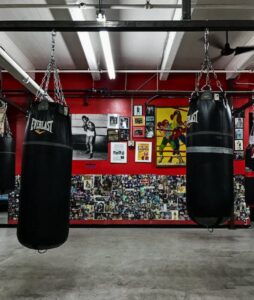
The DUMBO BID began in 2006 and we haven’t stopped promoting the neighborhood since: the BID brings you public art, free WiFi, Archway events, the DOE Fund, #DUMBOVIP and, yes, this timeline. We water the plants, clean the streets and work with community members – from small businesses to tech giants, residents to property owners, the Park to DOT, and many many more. Explore our website for more information about DUMBO today!
DUMBO’S HISTORY IS NOW
DUMBO thrives because of its history and because of how the neighborhood pairs cutting-edge innovation with historic preservation and adaptive re-use. Our beloved Belgian Block streets are a staple of the neighborhood’s unique character, and we’re working hard to keep their special shine! Hallmark DUMBO projects include the transformation of the Empire Stores tobacco warehouse into the home of the world-famous St. Ann’s Warehouse. DUMBO developer Two Trees converted Robert Gair’s campus of poured concrete factories into a range of offices and apartments, while Alloy Development has reinvigorated the brick factories of Charles Arbuckle.
As you walk around the neighborhood, take a moment to notice the mix of old and new that makes the streets of DUMBO Brooklyn's finest.
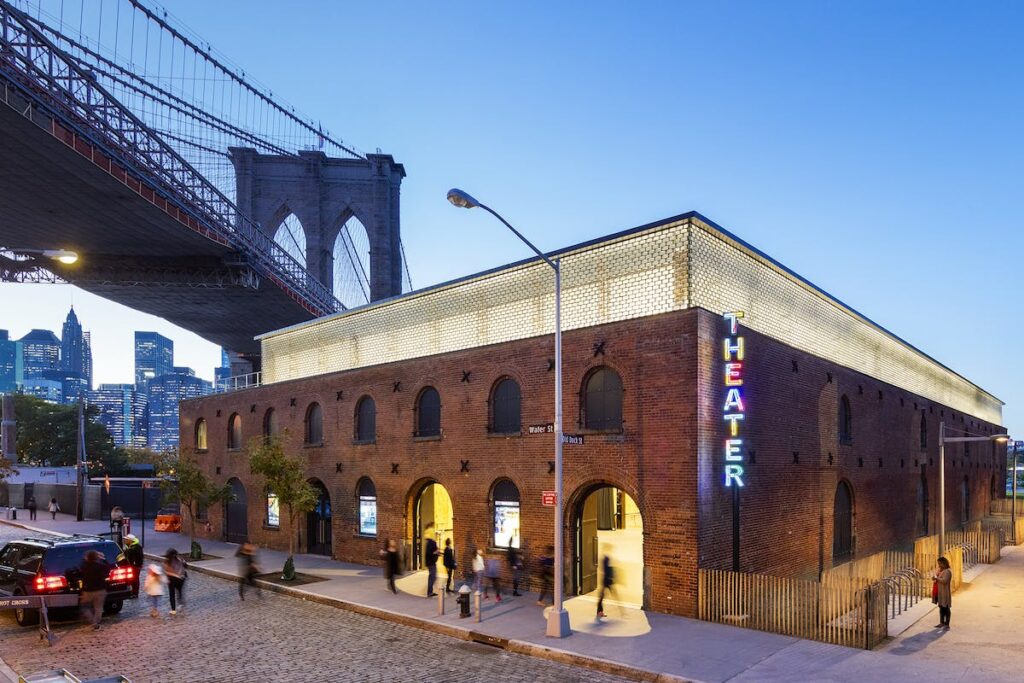

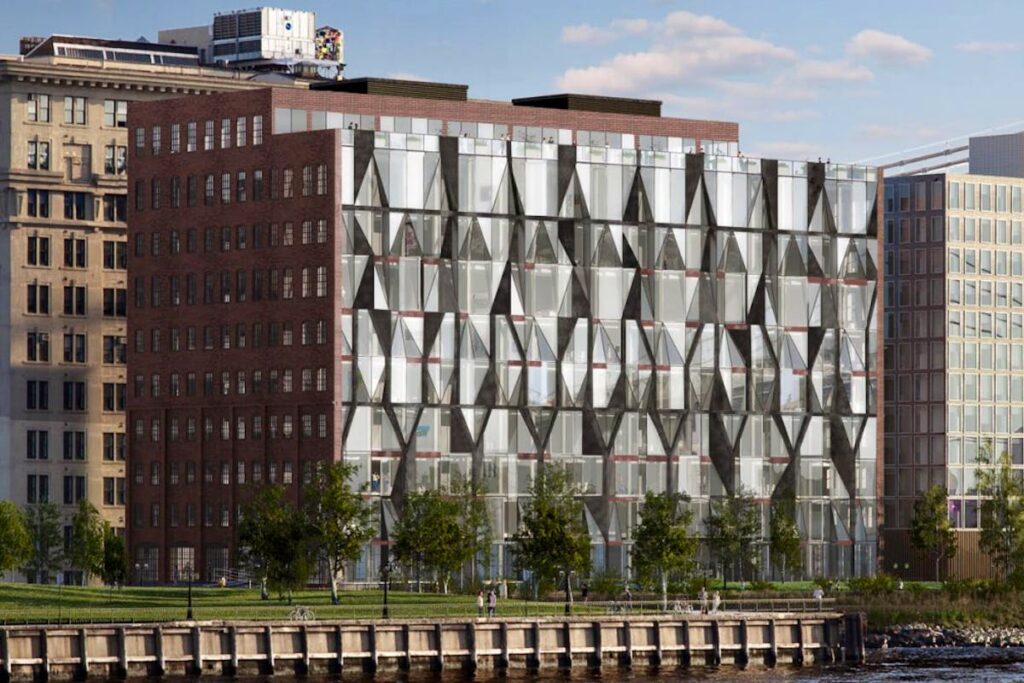
INTERESTED IN LEARNING MORE ABOUT THE HISTORY OF DUMBO?
DIG IN DEEPER:
- The History of DUMBO, the Brooklyn neighborhood built upon a legacy of coffee and cardboard boxes by the Bowery Boys.
- Welcome to BHS Dumbo by Flatbush + Main, the Brooklyn Historical Society podcast
- Revisiting Brooklyn Historical Society DUMBO by Flatbush + Main, the Brooklyn Historical Society podcast
- Book a historical walking tour of DUMBO with Turnstile Tours
OUR SOURCES
WE OWE A DEBT OF GRATITUDE TO THE FOLLOWING, AS WE COMPILED THIS BRIEF HISTORY OF DUMBO.
- The Dumbonians we interviewed as part of our oral history project
- The DUMBO Historic District designation report
- Andrew Gustafson from Turnstile Tours (andrew@turnstiletours.com)
- Brownstoner’s excellent History Stream
- The Brooklyn Historical Society “Waterfront” exhibit, which was in Empire Stores from 2017-2019
- Materials from the Brooklyn Historical Society archives (Othmer Library)
- “A History of the City of Brooklyn” by Henry Reed Stiles
- “The Indians of Brooklyn in the Days of the Dutch” edited by William Christie MacLeod
- “The Olympia Settlement in early Brooklyn, N.Y.” by Eugene L. Armbruster
- “Robert Gair: A Study” by H. Allen Smith
- “Place Names in Olympia” by Irwin Schecter



